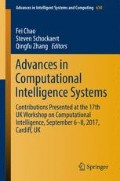Abstract
Keyphrases provide important semantic metadata for organizing and managing free-text documents. As data grow exponentially, there is a pressing demand for automatic and efficient keyphrase extraction methods. We introduce in this paper SemCluster, a clustering-based unsupervised keyphrase extraction method. By integrating an internal ontology (i.e., WordNet) with external knowledge sources, SemCluster identifies and extracts semantically important terms from a given document, clusters the terms, and, using the clustering results as heuristics, identifies the most representative phrases and singles them out as keyphrases. SemCluster is evaluated against two baseline unsupervised methods, TextRank and KeyCluster, over the Inspec dataset under an F1-measure metric. The evaluation results clearly show that SemCluster outperforms both methods.
Access this chapter
Tax calculation will be finalised at checkout
Purchases are for personal use only
Notes
- 1.
- 2.
- 3.
DBpedia schema is available at http://mappings.dbpedia.org/server/ontology/classes/.
- 4.
The alignment results are available at http://www.pdlab.io/semcluster/inspec.rar.
- 5.
The lookup code is available at https://github.com/dbpedia/lookup.
- 6.
ESA code is available at http://treo.deri.ie/easyesa/.
- 7.
- 8.
Wordnet v.3.1 is available at https://wordnet.princeton.edu/wordnet/download.
- 9.
Hulth’s dataset copy is available at http://pdllab.io/semcluster/inspec.rar.
References
Turney, P.D.: Learning algorithms for keyphrase extraction. Inf. Retr. 2(4), 303–336 (2000)
Hasan, K.S., Ng, V.: Automatic keyphrase extraction: a survey of the state of the art. In: Proceedings of the 52nd Annual Meeting of the Association for Computational Linguistics, pp. 1262–1273 (2014)
Washio, T., Motoda, H.: State of the art of graph-based data mining. ACM SIGKDD Explor. Newsl. 5(1), 59–68 (2003)
Sonowane, S.S., Kulkarni, P.A.: Graph based representation and analysis of text document: a survey of techniques. Int. J. Comput. Appl. 96, 1–8 (2014)
Mihalcea, R., Tarau, P.: TextRank: bringing order into texts. Association for Computational Linguistics (2004)
Liu, Z., Li, P., Zheng, Y., Sun, M.: Clustering to find exemplar terms for keyphrase extraction. In: Proceedings of the 2009 Conference on Empirical Methods in Natural Language Processing, pp. 257–266 (2009)
Steier, A.M., Belew, R.K.: Exporting phrases: a statistical analysis of topical language. In: Second Symposium on Document Analysis and Information Retrieval, pp. 179–190 (1993)
Barker, K., Cornacchia, N.: Using noun phrase heads to extract document keyphrases. In: Conference of the Canadian Society for Computational Studies of Intelligence, pp. 40–52. Springer (2000)
Litvak, M., Last, M.: Graph-based keyword extraction for single-document summarization. In: Proceedings of the Workshop on Multi-source Multilingual Information Extraction and Summarization, pp. 17–24 (2008)
Page, L., Brin, S., Motwani, R., Winograd, T.: The PageRank citation ranking: bringing order to the web. Technical Report, Stanford InfoLab (1999)
Tsatsaronis, G., Varlamis, I., Nrvg, K.: SemanticRank: ranking keywords and sentences using semantic graphs. In: Proceedings of the 23rd International Conference on Computational Linguistics, pp. 1074–1082 (1999)
Bracewell, D.B., Ren, F., Kuriowa, S.: Multilingual single document keyword extraction for information retrieval. In: Proceedings of 2005 IEEE International Conference on Natural Language Processing and Knowledge Engineering, pp. 517–522 (2005)
Hulth, A.: Improved automatic keyword extraction given more linguistic knowledge. In: Proceedings of the 2003 Conference on Empirical Methods in Natural Language Processing, pp. 216–223. Association for Computational Linguistics (2003)
Miller, G.A., Beckwith, R., Fellbaum, C., Gross, D., Miller, K.J.: Introduction to WordNet: an on-line lexical database. Int. J. Lexicogr. 3(4), 235–244 (1990)
Alrehamy, H., Walker, C.: Personal data lake with data gravity pull. In: Proceedings of the 2015 IEEE Fifth International Conference on Big Data and Cloud Computing, pp. 160–167 (2015)
Navigli, R.: Word sense disambiguation: a survey. ACM Comput. Surv. 41(2) (2009)
Patwardhan, S., Banerjee, S., Pedersen, T.: SenseRelate::TargetWord: a generalized framework for word sense disambiguation. In Proceedings of the ACL 2005 on Interactive Poster and Demonstration Sessions, pp. 73–76. Association for Computational Linguistics (2005)
Meng, L., Huang, R., Gu, J.: A review of semantic similarity measures in WordNet. Int. J. Hybrid Inf. Technol. 6(1), 1–12 (2013)
Wu, Z., Palmer, M.: Verbs semantics and lexical selection. In: Proceedings of the 32nd Annual Meeting on Association for Computational Linguistics, pp. 133–138. Association for Computational Linguistics (1994)
Frey, B.J., Dueck, D.: Clustering by passing messages between data points. Science 315(5814), 972–976 (2007)
Liu, F., Pennell, D., Liu, F., Liu, Y.: Unsupervised approaches for automatic keyword extraction using meeting transcripts. In: Proceedings of Human Language Technologies, pp. 620–628. Association for Computational Linguistics (2009)
Gabrilovich, E., Markovitch, S.: Computing semantic relatedness using Wikipedia-based explicit semantic analysis. In: Proceedings of the 20th International Joint Conference on Artificial Intelligence, pp. 1606–1611 (2007)
Witten, I., Milne, D.: An effective, low-cost measure of semantic relatedness obtained from Wikipedia links. In: Proceeding of AAAI Workshop on Wikipedia and Artificial Intelligence: An Evolving Synergy, pp. 25–30. AAAI Press, Chicago (2008)
Bergstra, J., Bengio, Y.: Random search for hyper-parameter optimization. J. Mach. Learn. Res. 13(2), 281–305 (2012)
Jiang, J.J., Conrath, D.W.: Semantic similarity based on corpus statistics and lexical taxonomy. arXiv preprint http://arxiv.org/abs/cmp-lg/9709008 (1997)
Moro, A., Cecconi, F., Navigli, R.: Multilingual word sense disambiguation and entity linking for everybody. In: Proceedings of the 2014 International Conference on Posters and Demonstrations, pp. 25–28. CEUR-WS.org (2014)
Guan, R., Shi, X., Marchese, M., Yang, C., Liang, Y.: Text clustering with seeds affinity propagation. IEEE Trans. Knowl. Data Eng. 23(4), 627–637 (2011)
Author information
Authors and Affiliations
Corresponding author
Editor information
Editors and Affiliations
Rights and permissions
Copyright information
© 2018 Springer International Publishing AG
About this paper
Cite this paper
Alrehamy, H.H., Walker, C. (2018). SemCluster: Unsupervised Automatic Keyphrase Extraction Using Affinity Propagation. In: Chao, F., Schockaert, S., Zhang, Q. (eds) Advances in Computational Intelligence Systems. UKCI 2017. Advances in Intelligent Systems and Computing, vol 650. Springer, Cham. https://doi.org/10.1007/978-3-319-66939-7_19
Download citation
DOI: https://doi.org/10.1007/978-3-319-66939-7_19
Published:
Publisher Name: Springer, Cham
Print ISBN: 978-3-319-66938-0
Online ISBN: 978-3-319-66939-7
eBook Packages: EngineeringEngineering (R0)

